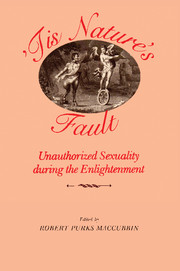Book contents
- Frontmatter
- Contents
- Introduction
- “The Secrets of Generation Display'd”: Aristotle's Master-piece in Eighteenth-Century England
- Sexual Imagination as Revealed in the Traité des superstitions of Abbé Jean-Baptiste Thiers
- Married but not Churched: Plebeian Sexual Relations and Marital Nonconformity in Eighteenth-Century Britain
- Moral Values in “La Suite de l'Entretien”
- Prostitution and Reform in Eighteenth-Century England
- The Properties of Libertinism
- Between the Licit and the Illicit: the Sexuality of the King
- The Sublimations of a Fetishist: Restif de la Bretonne (1734-1806)
- Sodomitical Subcultures, Sodomitical Roles, and the Gender Revolution of the Eighteenth Century: The Recent Historiography
- The Priest, the Philosopher, and Homosexuality in Enlightenment France
- The Pursuit of Homosexuality in the Eighteenth Century: “Utterly Confused Category” and/or Rich Repository?
- Sodomy in the Dutch Republic during the Eighteenth Century
- Parisian Homosexuals Create a Lifestyle, 1700-1750: The Police Archives
- The Censor Censured: Expurgating Memoirs of a Woman of Pleasure
- Chthonic and Pelagic Metaphorization in Eighteenth-Century English Erotica
- Modes of Discourse and the Language of Sexual Reference in Eighteenth-Century French Fiction
- The Mélange de poésies diverses (1781) and the Diffusion of Manuscript Pornography in Eighteenth-Century France
- Obscene Literature in Eighteenth-Century Italy: an Historical and Bibliographical Note
Chthonic and Pelagic Metaphorization in Eighteenth-Century English Erotica
Published online by Cambridge University Press: 06 July 2010
- Frontmatter
- Contents
- Introduction
- “The Secrets of Generation Display'd”: Aristotle's Master-piece in Eighteenth-Century England
- Sexual Imagination as Revealed in the Traité des superstitions of Abbé Jean-Baptiste Thiers
- Married but not Churched: Plebeian Sexual Relations and Marital Nonconformity in Eighteenth-Century Britain
- Moral Values in “La Suite de l'Entretien”
- Prostitution and Reform in Eighteenth-Century England
- The Properties of Libertinism
- Between the Licit and the Illicit: the Sexuality of the King
- The Sublimations of a Fetishist: Restif de la Bretonne (1734-1806)
- Sodomitical Subcultures, Sodomitical Roles, and the Gender Revolution of the Eighteenth Century: The Recent Historiography
- The Priest, the Philosopher, and Homosexuality in Enlightenment France
- The Pursuit of Homosexuality in the Eighteenth Century: “Utterly Confused Category” and/or Rich Repository?
- Sodomy in the Dutch Republic during the Eighteenth Century
- Parisian Homosexuals Create a Lifestyle, 1700-1750: The Police Archives
- The Censor Censured: Expurgating Memoirs of a Woman of Pleasure
- Chthonic and Pelagic Metaphorization in Eighteenth-Century English Erotica
- Modes of Discourse and the Language of Sexual Reference in Eighteenth-Century French Fiction
- The Mélange de poésies diverses (1781) and the Diffusion of Manuscript Pornography in Eighteenth-Century France
- Obscene Literature in Eighteenth-Century Italy: an Historical and Bibliographical Note
Summary
In Shakespeare's Venus and Adonis (1593), the goddess of love, while trying to seduce a coyly reluctant Adonis, compares her body to a deer park and develops the metaphor of her erotic topography with graphic precision:
I'll be a park, and thou shalt be my deer.
Feed where thou wilt, on mountain, or in dale;
Graze on my lips, and if those hills be dry,
Stray lower, where the pleasant fountains lie.
Within this limit is relief enough,
Sweet bottom-grass, and high delightful plain,
Round rising hillocks, brakes obscure and rough,
To shelter thee from tempest, and from rain.
(11.229-38)Beyond the popular Ovidian tradition, Shakespeare was availing himself of a stock of erotic imagery as ancient as the “Song of Songs,” with its subtle blend of sacred and profane love in the description of the female body. Its metaphorical transmutation into a country described with (apparently) painstaking topographical accuracy is not particular to eighteenth-century erotica, but was first used—at least in book-length form—in Erotopolis: The Present State of Betty-Land (1684), attributed to Charles Cotton. In France, La Mothe Le Vayer (1588-1672) published his Hexaméron rustique in 1670, in which the chapter devoted to the fourth day gives a most ingenious, if covertly bawdy, interpretation of Homer's description of the Naiads' cave in Book 13 of the Odyssey. La Mothe Le Vayer's interpretation rests on a line-by-line and nearly word-by-word gloss of Homer's text.
- Type
- Chapter
- Information
- 'Tis Nature's FaultUnauthorized Sexuality during the Enlightenment, pp. 202 - 216Publisher: Cambridge University PressPrint publication year: 1988

